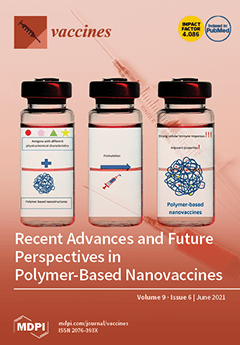Open AccessArticle
Attitudes towards the COVID-19 Vaccine and Willingness to Get Vaccinated among Healthcare Workers in French Guiana: The Influence of Geographical Origin
by
Nicolas Vignier, Kepha Brureau, Sybille Granier, Jacques Breton, Céline Michaud, Mélanie Gaillet, Camille Agostini, Mathilde Ballet, Mathieu Nacher, Audrey Valdes, Philippe Abboud, Antoine Adenis, Félix Djossou, Loïc Epelboin and Maylis Douine
Cited by 28 | Viewed by 4582
Abstract
Background: In the context of the global COVID-19 pandemic and the expansion of the more transmissible 20J/501Y.V3 (Gamma) variant of concern (VOC), mRNA vaccines have been made available in French Guiana, an overseas French territory in South America, from mid-January 2021. This study
[...] Read more.
Background: In the context of the global COVID-19 pandemic and the expansion of the more transmissible 20J/501Y.V3 (Gamma) variant of concern (VOC), mRNA vaccines have been made available in French Guiana, an overseas French territory in South America, from mid-January 2021. This study aimed to estimate the willingness to be vaccinated and the socio-demographic and motivational correlates among Health Care Workers (HCWs) in French Guiana.
Methods: A cross-sectional survey was conducted from January 22 to March 26, 2021 among a sample of HCWs in French Guiana. They were asked about their willingness to get vaccinated against COVID-19 and vaccine hesitancy, vaccine uptake and vaccines attitudes. Factors associated with willingness to get vaccinated have been analyzed with ordinal logistic regression, using Stata software.
Results: A total of 579 HCWs were interviewed, including 220 physicians and 200 nurses most often working in hospital (54%) or in the liberal sector (22%). Overall, 65.6% of respondents reported that they were willing or had already been vaccinated against COVID-19, while 24.3% of respondents reported that they did not want to get vaccinated against COVID-19 and 11.2% were unsure. HCWs were more willing to get vaccine if they were older, were worried about COVID-19 and were confident in the management of epidemic. Conversely, participants were less likely to have been vaccinated or willing to if they were nurses or of another non-medical profession, born in French Guiana, feared adverse effects, or if they did not trust pharmaceutical companies and management of the epidemic by authorities.
Conclusion: Negative attitudes towards vaccines are a major public health concern among HCWs in French Guiana when considering the current active epidemic with Gamma VOC. General vaccine hesitancy and concerns about future side effects in particular represent important barriers. Low confidence in government and science are significant in COVID-19 vaccine refusal among non-medical staffs. Public health messaging with information on vaccine safety should be tailored to address these concerns. The specific challenges of HCWs from French Guiana must be taken into account.
Full article






